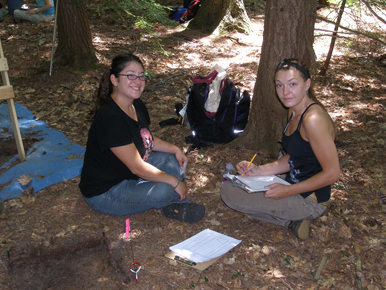Big Dig
Native American site discovered at BU's Sargent Center

Little is known of the Native American tribes that roamed New England forests thousands of years ago, but an archaeological survey conducted last month at Boston University’s Sargent Center for Outdoor Education, in New Hampshire’s Monadnock region, has uncovered tantalizing evidence of the area’s earliest inhabitants.
Last spring, Robert Goodby, a professor of anthropology at Franklin Pierce College, approached Sargent Center officials about the possibility of an archaeological dig on the Hancock, N.H., property. “The U.S. Army Corps of Engineers discovered sites along the river, directly to the south of Sargent Center,” he says. “So I had a strong suspicion we’d find more on the property itself.
“This dig was particularly important,” he continues, “because up until the last decade, there was little evidence of Native American occupation in the Monadnock region.”

In July, Goodby moved his classroom to the banks of the Nubanusit Rive r, where he and eight students hoped to unearth remnants of the area’s distant past.
r, where he and eight students hoped to unearth remnants of the area’s distant past.
It didn’t take long. The first day they recovered quartz chips, a broken quartz tool, and a piece of pottery. By the end of the third week, they had found more than 1,000 objects, including arrowheads, spear points, and animal bones, and on the final day, they discovered the remains of a small cooking hearth. “Because of the site’s remote location,” Goodby says, “the soil was virtually undisturbed, and the artifacts were in surprisingly good condition.”
Situated between the Nubanusit River and the outskirts of a large wetlands area, the site is one of the largest in New Hampshire, measuring nearly 500 square yards. “Tribes traveling by canoe would have found an abundance of food and other resources in the wetlands,” Goodby says. “The soil is sandy and well-drained, which was ideal for settlement.”
Using handheld trowels and shovels, Goodby’s students dug 19.5-inch holes at 9-yard intervals. “Most of us had spent more time looking at pictures in books than at actual stone tools,” says senior anthropology major Vanessa Giraldo, “so spotting genuine tool fragments was pretty challenging.”
While the artifacts indicate the site was repeatedly occupied between 1,000 and 6,000 years ago, it’s impossible to know by whom. Traces of the fine-grained sedimentary rock called chert and the metamorphic stone quartzite — neither native to the Monadnock region — indicate the tribes also traveled through the Upper Hudson River Valley and central Vermont. “Most likely they were ancestors of the Abenaki, a tribe of hunters and gatherers whose descendants still live in the area today,” Goodby says.
Further lab analysis will provide additional information on the artifacts’ age and origins, he says. Goodby hopes to return to Sargent Center for future digs to learn more about the area’s history.
“We’re looking forward to collaborating with Dr. Goodby on many forthcoming projects,” says Robert Rubendall, director of Sargent Center. “Finding evidence of human activity that dates back four millennia is very exciting, and we intend to learn as much as we can from it.”
Founded by Dudley Allen Sargent in 1912, the Sargent Center for Outdoor Education began as Sargent Camp. It was acquired by Boston University in 1932, and it became the summer location for Sargent College’s physical education and health majors. Today, the camp features 25 miles of hiking trails, a 60-acre pond, a high ropes course, and basketball and volleyball courts.
Vicky Waltz can be reached at vwaltz@bu.edu.